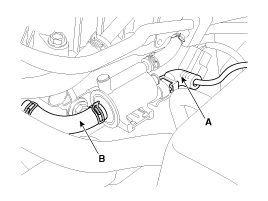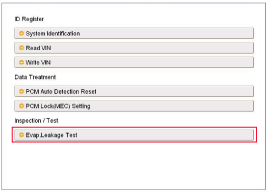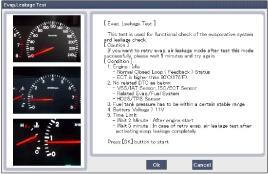 Kia Optima: Repair procedures
Kia Optima: Repair procedures
Inspection
[System Inspection]
|
1. |
Disconnect the vapor hose from the throttle body
and connect a vacuum pump to the nipple on the throttle body. |
|
2. |
Check the following points with applied vacuum using
a vacuum pump. ┬Ę At Cold Engine [Engine Coolant Temperature < 60┬░C(140┬░F)]
Engine
Operating
Condition
|
Applied
Vacuum
|
Result
|
Idle
|
14.5 inHg
(0.5 kgf/cm², 49.0kPa)
|
Vacuum is held
|
3,000rpm
|
┬Ę At Warmed Engine [Engine Coolant Temperature >
80┬░C(176┬░F)]
Engine
Operating
Condition
|
Applied
Vacuum
|
Result
|
Idle
|
14.5 inHg
(0.5 kgf/cm², 49.0kPa)
|
Vacuum is held
|
Within 3 minutes after engine start at 3,000
rpm
|
Try to apply vacuum
|
Vacuum is released
|
In 3 minutes after engine start at 3,000 rpm
|
14.5 inHg
(0.5 kgf/cm², 49.0kPa)
|
Vacuum will be held momentarily, after which,
it will be released
|
|
[PCSV Inspection]
|
1. |
Turn ignition switch OFF and disconnect the negative
(-) battery cable. |
|
2. |
Disconnect the PCSV connector (A). |
|
3. |
Disconnect the vapor hose (B) which is connected
to the intake manifold from the PCSV.

|
|
4. |
After connecting a vacuum pump to the nipple, apply
vacuum. |
|
5. |
With the PCSV control line grounded, check the valve
operation with battery voltage applied to the PCSV(Open) and removed(Closed).
Battery Voltage
|
Valve
|
Vacuum
|
Connected
|
Open
|
Released
|
Disconnected
|
Close
|
Maintained
|
|
|
6. |
Measure the coil resistance of the PCSV.
Specifications:
19.0 ~ 22.0Ω [20┬░C(68┬░F)]
|
|
[EVAP. Leakage Test]
|
1. |
Select "Evap. Leakage Test".

|
|
2. |
Proceed with the test according to the screen introductions.

|
Schematic Diagram
CanisterThe Canister is filled with charcoal and absorbs evaporated
fuel vapor from the fuel tank. The gathered fuel vapor in canister is drawn
into the intake manifold b ...
See also:
Replacements
Door Trim Replacement
ŌĆó
Be careful not to scratch
the door trim and other parts.
ŌĆó
...
Components (With EPB)
1. Guide rod bolt
2. Bleed screw
3. Caliper carrier
4. Caliper body
5. Brake pad
6. Pad retainer
...
Components and Components Location
Components
1. Steering wheel
2. Steering column
3. ECU
4. Motor
5. Steering gear box
MDPS Circuit Diagram
Harness Connector
...
 Kia Optima: Repair procedures
Kia Optima: Repair procedures Schematic Diagrams
Schematic Diagrams



